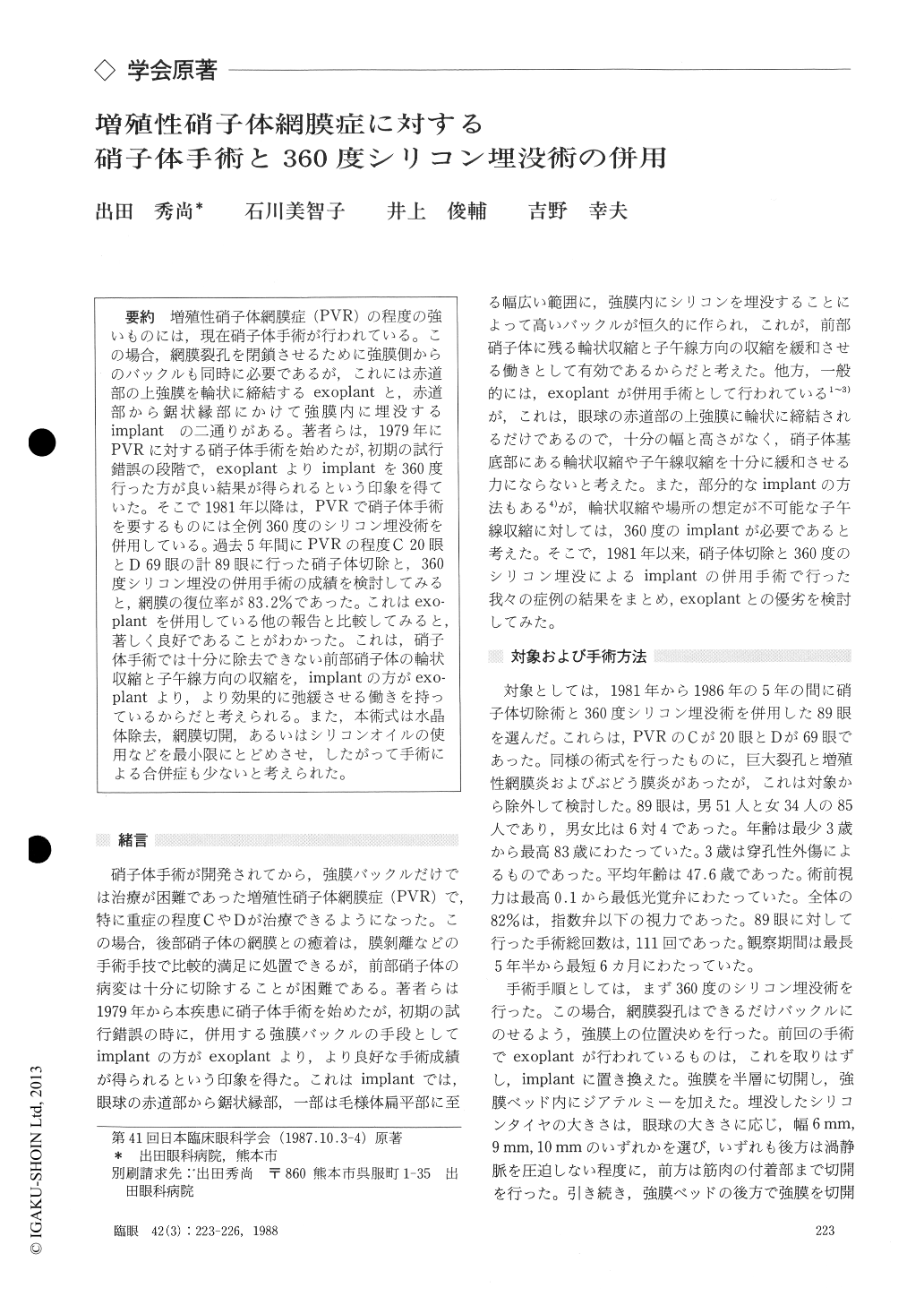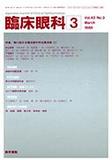Japanese
English
- 有料閲覧
- Abstract 文献概要
- 1ページ目 Look Inside
増殖性硝子体網膜症(PVR)の程度の強いものには,現在硝子体手術が行われている.この場合,網膜裂孔を閉鎖させるために強膜側からのバックルも同時に必要であるが,これには赤道部の上強膜を輪状に締結するexoplantと,赤道部から鋸状縁部にかけて強膜内に埋没するimplantの二通りがある.著者らは,1979年にPVRに対する硝子体手術を始めたが,初期の試行錯誤の段階で,exoplantよりimplantを360度行った方が良い結果が得られるという印象を得ていた.そこで1981年以降は,PVRで硝子体手術を要するものには全例360度のシリコン埋没術を併用している.過去5年間にPVRの程度C20眼とD69眼の計89眼に行った硝子体切除と,360度シリコン埋没の併用手術の成績を検討してみると,網膜の復位率が83.2%であった.これはexo-plantを併用している他の報告と比較してみると,著しく良好であることがわかった.これは,硝子体手術では十分に除去できない前部硝子体の輪状収縮と子午線方向の収縮を,implantの方がexo-plantより,より効果的に弛緩させる働きを持っているからだと考えられる.また,本術式は水晶体除去,網膜切開,あるいはシリコンオイルの使用などを最小限にとどめさせ,したがって手術による合併症も少ないと考えられた.
In treating proliferative vitreoretinopathy (PVR), the posterior vitreous is easily completely removed but the anterior vitreous is not. We found this incomplete removal better compensated for by a 360° silicone implant than by an exoplant, because the implant provides a high broad buckle on the anterior globe, while the exoplant provides only a low narrow buckle on the equator.
Between 1981 and 1986 we treated 89 eyes with PVR by vitrectomy combined with the implant. The 89 eyes included 20 PVR-C and 69 PVR-D. There were 51 males and 34 females, 3 to 83 years old, averaging 47.6 years. Preoperative vision ran-ged from 0.1 to LP, with 82% below CF. 48 eyes had no previous retinal or vitreous surgery, 31 had it once, and 10 had it twice or more. 51 were phakic and 38 aphakic. Silicone tire was undermined in the sclera along the whole circumference prior to vitrectomy. When the fundus was obscured by lens or vitreous opacity, vitrectomy was performedprior to the undermining. Subretinal fluid was drained externally, and the vitreous was replaced with saline, air, or gas. Surgery on the 89 eyes was performed 111 times. Ancillary surgical procedures were applied as follows : silicone oil 19 eyes, len-sectomy 9, sponge exoplant 4, subretinal band sev-erance 2, retinotomy 2, and retinal tag 1. Intraoper-ative complications were 4 iatrogenic retinal breaks, 1 vitreous hemorrhage, and 1 subretinal silicone oil.
The observation period was 6 months to 5.5 years. Anatomical reattachment rate of the retina was 83.2%. Postoperative vision ranged from 0.3 to no LP. 60.7% improved, 23.6% were unchanged, and 15.7% worsened. 44% were below CF. Postoper-ative complications were 9 glaucomas, 4 hemor-rhages, 3 cataracts, 2 inflammations, 1 corneal opacity, and 1 rubeosis iridis. We attribute our comparatively high reattachment rate of 83.2% to the permanent, high broad, 360ー implant in the anterior globe. The implant also minimizes unnec-essary lensectomy, retinotomy, and silicone oil use.
Rinsho Ganka (Jpn J Clin Ophthalmol) 42(3) : 223-226, 1988

Copyright © 1988, Igaku-Shoin Ltd. All rights reserved.


